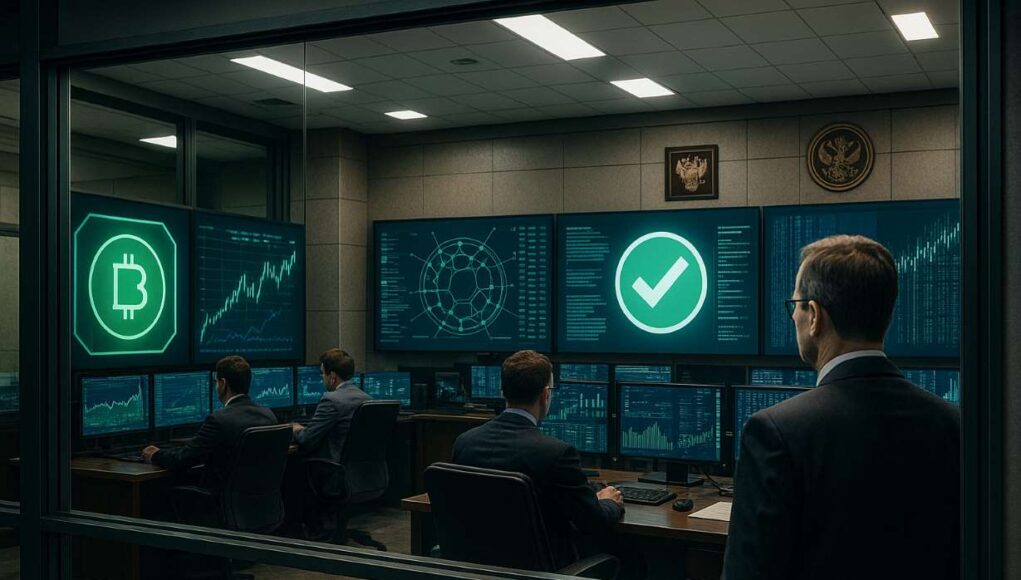Russia’s crypto ecosystem appears dynamic, but it’s anything but decentralized. At the center of this contradiction lies a network of Russian crypto platforms licensed, state-supervised, and aligned with geopolitical goals. They issue digital assets, tokenize bonds, and operate blockchain pilots. Yet all activity is curbed by strict regulatory oversight.
These aren’t disruptive startups challenging the financial status quo. They are government-aligned instruments. Private in name, public in practice, they exist to reinforce, not erode, state control.
Private, but Not Independent
Crypto issuance in Russia falls under the Digital Financial Assets (DFA) law, and the Central Bank of Russia (CBR) enforces this framework. Platforms must obtain a CBR license and run on permissioned blockchains to operate legally. Further, they can only issue pre-approved digital assets.
The CBR defines technical and legal standards. It also bans retail investors from participating. There are no user wallets, no DeFi links, and no cross-border interoperability. In other words, Russia’s crypto platforms function in a closed regulatory sandbox built for institutions.
Key Players in Russia’s Crypto Platform Network
Three platforms currently dominate Russia’s crypto space. All are technically private, but each serves state priorities.
- Sberbank DFA Platform: Operated by the country’s largest state-owned bank. It issues tokenized bonds, structured notes, and Bitcoin-linked products. Sber also acts as a liquidity provider in regulated markets.
- Atomyze: Originally funded by Norilsk Nickel, Atomyze tokenizes metals like palladium for use in state-approved industrial flows. It is obviously deeply tied to Russia’s strategic resource exports.
- Lighthouse: The first to issue ruble-denominated digital bonds. Lighthouse facilitates asset tokenization for government entities and state-aligned financial institutions.
These platforms are aligned with state entities or sanctioned business groups. Their design and function support sovereign finance objectives, not decentralized innovation.
Controlled Innovation by Design
Innovation is allowed, but only within narrow boundaries.
All platforms run on closed, permissioned blockchains. There are no anonymous transactions, no access to open-source tools, and no public interoperability. Regulators must vet smart contracts in advance. Users cannot connect external tokens or wallets to these systems.
This setup forms a self-contained architecture. State regulators monitor everything, and nothing escapes oversight. In effect, Russia’s crypto platforms are digital extensions of state finance infrastructure.
What These Platforms Actually Do
Despite limits, these platforms are active. Their key use cases include:
- Tokenized bonds issued by state and corporate borrowers
- Palladium-backed instruments for energy and trade flows
- Cross-border settlement pilots for BRICS-aligned payments
- BTC-linked investment products for qualified institutions only
Each use case supports broader state strategies: financial sovereignty, export control, and sanctions resilience.
Innovation or Proxy Infrastructure?
At first glance, these platforms look like cutting-edge fintech. But they are closer to state-controlled sandboxes than market-driven innovators.
The CBR uses them to test tokenization without risking capital flight. The Finance Ministry, on the other hand, sees them as infrastructure to modernize sovereign finance. Participation is tightly limited, foreign or domestic.
Unlike open crypto networks, Russia’s crypto platforms reinforce command, not autonomy.
Conclusion
Russia’s crypto platforms may resemble private-sector fintech. But their purpose is public. They don’t decentralize power; they centralize it more efficiently.
These systems offer tokenized tools built for compliance, surveillance, and geopolitical strategy. Summing up, they serve the state first, and the market second.
As global crypto adoption accelerates, Russia is building a digital economy shaped by permission, not decentralization.
Coming Next
In the final piece of our series, we zoom out for a strategic analysis:
“Sanctions, Sovereignty, and Satoshi: Is Russia Building a Parallel Crypto Economy?”










